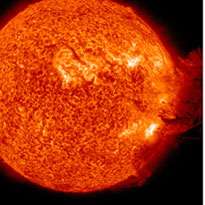Change in solar activity brings increased radiation risk to air passengers

(PhysOrg.com) -- Radiation risks to airplanes and spacecraft are likely to increase when the Sun moves from its present grand solar maximum to lower levels of activity, says research from the University of Reading.
The researchers say this a serious concern because our present day engineering, design, operation and insurance of vulnerable technology is based on past experience from the space age and does not yet account for long-term change in space climate.
The scientists have paid particular attention to the radiation effects on aircraft crew and passengers on long-distance flights.
The Sun has been in a ‘grand solar maximum' which has already lasted longer than any other such maximum in the past 9.3 millennia and is expected to end soon. The changes in near-Earth space that will result will return Earth to conditions that last prevailed before the advent of susceptible modern operational systems, such as spacecraft, power distribution grids and aircraft.
The study says that at cruise altitudes of commercial aviation, particularly at higher latitudes, high-energy ionising radiations such as Solar Energetic Particles (SEPs) and Galactic Cosmic Rays (GCRs) pose threats through single event upsets in electronics critical to flight safety, and through the radiation exposure of crew and passengers.
GCRs are high energy particles generated by supernovae explosions in our galaxy and, because of the shielding effect of our Sun's magnetic field, they give a continuous radiation dose throughout the solar system that increases during a solar activity minimum and decreases during a solar maximum. SEPs are bursts of energetic particles that are formed from supersonic ejections of material from the solar atmosphere.
The work was led by Mike Lockwood, professor of Space Environment Physics at the University of Reading and his PhD student Luke Barnard. Professor Lockwood said: "Radiation standards for avionics are based only on experience from the current grand solar maximum and there are no regulations concerning passenger exposure."
The International Commission on Radiological Protection (ICRP) recommends a 1 mSv limit for the annual dose received by a member of the public. Dosages during a flight depend on path, duration and altitude as well as on the level of solar activity. A commercial eight-hour polar flight during the 2003 ‘Halloween' SEP event would have given 70% of this recommended annual limit and it is estimated that the largest known SEP event, the ‘Carrington event' of 1859, would have given 20 times the limit.
Even without a SEP event, GCRs mean that the recommended limit corresponded to only five round trips (of two such flights each) during the recent solar minimum. The researchers at Reading have studied how these dosages are likely to increase in the future as solar activity declines.
Professor Lockwood said: "All the evidence suggests that the Sun will shortly exit from a grand solar maximum that has persisted since before the start of the space age. This analysis shows that the risk of the space-weather effects is considerably enhanced over the next century compared to the space age thus far."
The researchers use past experience to predict that there is an 8% chance of the Sun falling to grand minimum conditions over the next 40 years, giving enhanced dosages of GCR radiation which is of concern for aircraft avionics, crew and passengers. The risk of large SEP events is higher at middling levels of solar activity and so is initially enhanced in this case but then decreases to almost zero during the grand minimum itself.
A more likely scenario, predicted from the mean of all previous examples, is a more modest rise in the GCR fluxes but an enhanced risk of a large SEP event. There is only a 5% chance that the SEP risk and the GCR hazard will increase only slightly above those for the present solar cycle.
The study noted that both GCR and SEP events will be amplified by the probable continuation of the decrease in the geomagnetic field, and the shielding it provides, that has been observed over the past 160 years.
More information: ‘Predicting Space Climate Change' by L. Barnard, M. Lockwood, M.A. Hapgood, M.J. Owens, C.J. Davis and F. Steinhilber appears in Geophysical Research Letters, doi:10.1029/2011GL048489
Provided by University of Reading



















